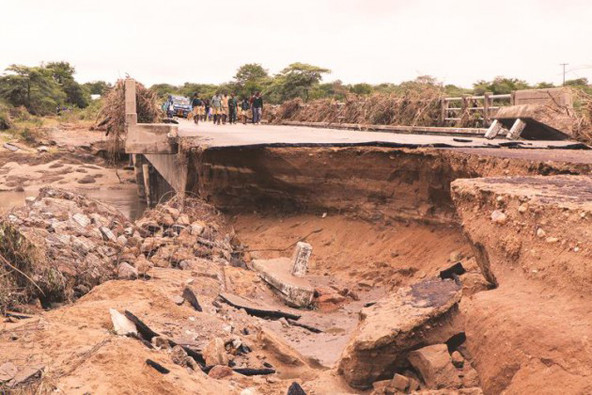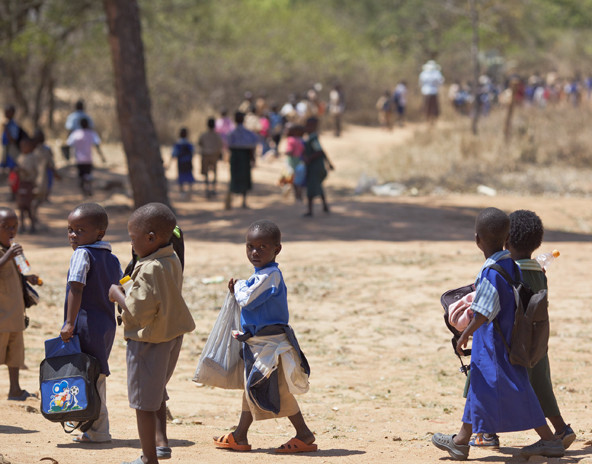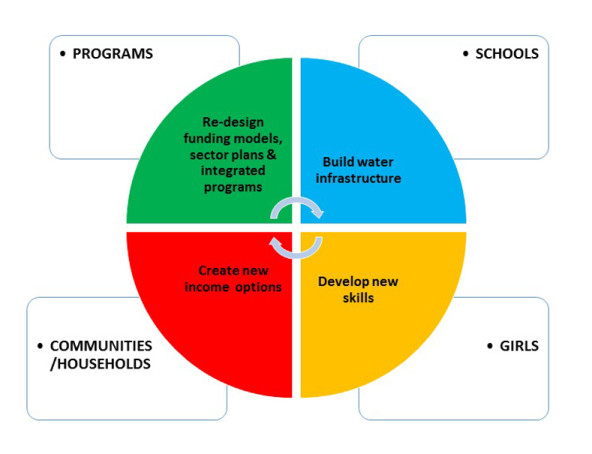In the past few years, Zimbabwe has experienced two extreme weather events, both of which had serious implications for schoolchildren. In February 2016, the government declared a state of disaster related to a severe El Nino-induced drought that contributed to 6,000 children in a single province dropping out of school due to hunger, and approximately 25 percent of children in some parts of the country were unable to attend school regularly. In March of this year, the Ministry of Local Government, Public Works and National Housing reported that floods had destroyed equipment and infrastructure—including toilets, boreholes, and entire classrooms—in 74 schools. These floods also washed away roads, bridges, and dams, which meant that many schoolchildren weren’t able to get to their schools in the aftermath of the crisis in any case.
 Rains trigger a state of disaster as floods destroy homes, bridges, and schools. (The Herald, February 2017)
Rains trigger a state of disaster as floods destroy homes, bridges, and schools. (The Herald, February 2017)
Events such as these are an integral part of the contexts in which educational development efforts must operate—and yet many educational programs neglect to plan appropriately for them, particularly with regard to the most marginalized communities and populations. The climate factor has not been fully incorporated into education sector planning, education program design, and donor funding models, which makes it difficult for the sector to anticipate and/or respond to such natural crises.

The 2016 Global Monitoring Report, challenged governments and civil society to match learning to the context. But it is an extremely difficult problem to overcome, especially when one considers the interrelated challenges of making education accessible to all children, including the nine percent globally who don’t attend school at all.
As a 2016 Echidna Global Scholar at the Brookings Institution in Washington, D.C., I was able to explore the links between girls’ education and drought in Zimbabwe. This research enabled me to gain a better understanding of the unique barriers posed to girls by climate change, particularly in rural contexts, and the innovative solutions that may contribute to a climate-resilient education system for girls and more broadly for all schoolchildren in these areas.
I found that droughts threaten to disrupt children’s educational continuity in the following ways:
- As household food insecurity increases, children find it difficult to concentrate in class due to hunger.
- School attendance is reduced as girls and boys invest more energy and time to help with chores that are linked to accessing much needed water, fuel-wood, and food.
- School attendance is further threatened—and the risk of abuse and exploitation increases—as households adopt negative coping mechanisms such as resorting to early marriage and child labor.
- Households face reduced economic capacity to support education as adverse climatic conditions affect rural livelihoods.
 Children walking to school in rural Zimbabwe. (Photo by John Estey/CARE, 2011)
Children walking to school in rural Zimbabwe. (Photo by John Estey/CARE, 2011)
But I was also able to develop a framework that I think would be useful for stakeholders working in this field. This framework, described in detail in the policy brief I produced during my residency at Brookings, is designed to leverage education as a platform for building resilience to climate change at multiple levels—program, school, and community—with the overall aim of ensuring that every girl and boy continues to learn, even during climate-related crises.
This framework advocates for a shift in the way in which education programs are designed to ensure that the realities of climate change are fully considered. But it also includes—and relies on—a shift in the way in which donors fund education programs. In order for this framework to have its intended effect, donors need to guarantee flexibility in education funding models, and commit to including mechanisms such as crisis modifiers and reserved resources for high frequency monitoring. These mechanisms will enable development actors to anticipate as well as respond to disasters such as droughts as needed.
 A framework for building resilience to climate change through education programming.
A framework for building resilience to climate change through education programming.
The framework also encourages governments to incorporate climate resilience as a core pillar of education sector plans. Doing so will ensure that decentralized contingency plans exist to deal with droughts, that any new infrastructure constructed is climate-resilient, and that there is motivation to develop skills for resilience—such as critical thinking, problem solving, and leadership—as part of the exit profile for learners. Lastly, for drought-prone areas, the framework highlights the need for a combination of interventions encompassing education, water, and food security through the development of climate resilient rural livelihood options, which will sustain the household economic capacity to support education.
One way to put this framework into practice is to establish school-based contingency planning, innovations that will support income generation, and safety nets such as seasonal provision of meals and water at school. In combination with CARE's Resilience Framework, such an approach would result in schools’ increased capacities to anticipate, absorb, and adapt to an array of shocks, stresses, and uncertainty that affect attendance and retention.
In drought-prone areas of Zimbabwe, for example, availability of water both at school and at home appears to be a critical factor for girls’ school attendance, given the challenges they face with regards to menstrual hygiene management and the role they play in fetching water for domestic use. Consequently, the installation of a solar powered water system at targeted schools could make a significant difference in girls’ attendance. A solar power system could also support lighting and the use of computers. And a water facility could also support income-generating projects, such as gardens—both as school-based science projects (which have the potential to support meal programs) and as demonstration sites for alternative livelihood options for communities.
To eliminate the risk of diverting attention from school, such a project would need to be managed by the community, for example through the clustered structure of community village savings and lending associations (CARE’s signature model for economic empowerment) already established in many countries, including Zimbabwe. The expectation is that households will be motivated to set up similar technologies at their homes and, through CARE, gain the capacity, knowledge, and networks they need to develop resilience at the household level. This would, in turn, ensure that households can support their children’s education even in the face of natural crises.
Schoolchildren—both girls and boys—would also participate in the management of this facility; with support from school authorities and the local community, they would learn how to be contributing and even leading members of a water committee. Mobile technology could also be integrated to enable users to keep track of the functionality of the borehole and manage it more effectively by providing real-time data. Learning to use such technology fluently would be a further benefit to schoolchildren and community members.
Such an innovation, geared towards drought-prone areas, represents just one possible approach to incorporating climate considerations in education policy and practice. If successful, it could be taken to scale as part of the work towards building a climate-resilient education system in Zimbabwe. But there is a great need for other ideas to address climate change in the context of education. I encourage funders to consider the framework I outlined above, and use it to further their own efforts to provide consistent educational opportunities for all.
Support SSIR’s coverage of cross-sector solutions to global challenges.
Help us further the reach of innovative ideas. Donate today.
Read more stories by Ellen Chigwanda.

